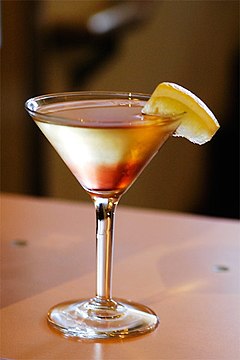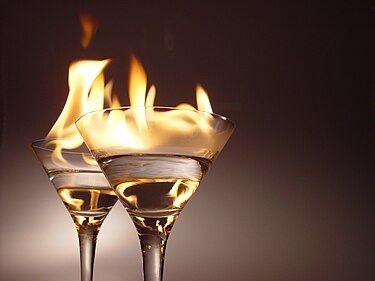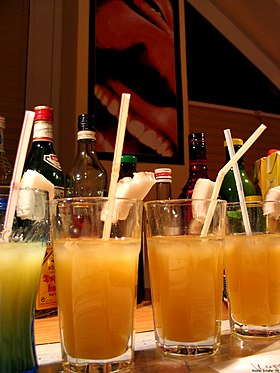| Revision as of 18:35, 10 January 2014 edit2602:306:3194:9250:24e9:2cd1:9f69:6d70 (talk) →Derivative usages← Previous edit | Revision as of 18:36, 10 January 2014 edit undo2602:306:3194:9250:24e9:2cd1:9f69:6d70 (talk) →Derivative usagesNext edit → | ||
| Line 98: | Line 98: | ||
| |last=Herpin | |last=Herpin | ||
| |publisher=Amazon Digital Services, INC. | |publisher=Amazon Digital Services, INC. | ||
| | |
|asin=B006CYMUHY | ||
| |year=2011 | |year=2011 | ||
| }}</ref> | }}</ref> | ||
Revision as of 18:36, 10 January 2014
This article is about the mixed drink containing alcohol. For other uses, see Cocktail (disambiguation). "Mixology" redirects here. For the ABC TV Series, see Mixology (TV series).
A cocktail is a kind of alcoholic mixed drink that contains two or more ingredients. As generally understood today, a cocktail requires at least one alcoholic component—typically a distilled spirit, although beer and wine are permissible—and one sweet component; it may also contain a souring or bittering ingredient. The completed cocktail is almost always garnished with fruit.
Cocktails were originally a mixture of spirits, sugar, water, and bitters. The term is now often used for almost any mixed drink that contains alcohol, including mixers, mixed shots, etc. A cocktail today usually contains one or more kinds of spirit and one or more mixers, such as soda or fruit juice, and various herbs.
History
The origin of the word cocktail is disputed.
The first recorded use of the word cocktail is found in The Morning Post and Gazetteer in London, England on March 20, 1798:
Mr. Pitt,
two petit vers of “L’huile de Venus”
Ditto, one of “perfeit amour”
Ditto, “cock-tail” (vulgarly called ginger)
The first recorded use of the word cocktail in the United States is said to be in The Farmer's Cabinet on April 28, 1803:
The word cocktail, according to the Oxford English dictionary, lists the word originating in the U.S.
Drank a glass of cocktail—excellent for the head...Call'd at the Doct's. found Burnham—he looked very wise—drank another glass of cocktail.
A definition of cocktail appeared in the May 13, 1806, edition of The Balance and Columbian Repository, a publication in Hudson, New York, in which an answer was provided to the question, "What is a cocktail?". It replied:
Cock-tail is a stimulating liquor, composed of spirits of any kind, sugar, water, and bitters—it is vulgarly called bittered sling, and is supposed to be an excellent electioneering potion, inasmuch as it renders the heart stout and bold, at the same time that it fuddles the head. It is said, also to be of great use to a democratic candidate: because a person, having swallowed a glass of it, is ready to swallow any thing else.

Compare the ingredients listed (spirits, sugar, water, and bitters) with the ingredients of an Old Fashioned, which originated as a term used by late 19th century bar patrons to distinguish cocktails made the “old-fashioned” way from newer, more complex cocktails.
The first publication of a bartenders' guide which included cocktail recipes was in 1862 — How to Mix Drinks; or, The Bon Vivant's Companion, by "Professor" Jerry Thomas. In addition to listings of recipes for Punches, Sours, Slings, Cobblers, Shrubs, Toddies, Flips, and a variety of other types of mixed drinks were 10 recipes for drinks referred to as "Cocktails". A key ingredient which differentiated "cocktails" from other drinks in this compendium was the use of bitters as an ingredient.
The first "cocktail party" ever thrown was allegedly by Mrs. Julius S. Walsh Jr. of St. Louis, Missouri, in May 1917. Mrs. Walsh invited 50 guests to her home at noon on a Sunday. The party lasted an hour, until lunch was served at 1 pm. The site of this first cocktail party still stands. In 1924, the Roman Catholic Archdiocese of St. Louis bought the Walsh mansion at 4510 Lindell Boulevard, and it has served as the local archbishop's residence ever since.
During Prohibition in the United States (1919–1933), when alcoholic beverages were illegal, cocktails were still consumed illegally in establishments known as speakeasies. The quality of liquor available during Prohibition was much worse than previously. There was a shift from whiskey to gin, which does not require aging and is therefore easier to produce illicitly. Honey, fruit juices, and other flavorings served to mask the foul taste of the inferior liquors. Sweet cocktails were easier to drink quickly, an important consideration when the establishment might be raided at any moment.
Cocktails became less popular in the late 1960s and through the 1970s, until resurging in the 1980s with vodka often substituting the original gin in drinks such as the martini. Traditional cocktails and gin began to make a comeback in the 2000s.
In September 2005, archaeochemist Patrick McGovern of the University of Pennsylvania announced the discovery of 5,000-year-old Mesopotamian earthenware from the banks of the Tigris between Iran and Iraq containing traces of tartaric acid, honey, apple juice and barley. McGovern described this early cocktail as "grog".
Derivative usages

The word cocktail is sometimes used figuratively for a mixture of liquids or other substances. Such a use might be, for example: "120 years of industry have dosed the area's soil with a noxious cocktail of heavy metals and chemical contaminants."
The word cocktail very likely derives from the term used to define half-breed racing mares in the 19th century.
A makeshift incendiary bomb consisting of a bottle of flammable liquid (usually gasoline) with a flaming rag attached is known as a "Molotov cocktail".
Combinations of antiretroviral drugs used as HIV/AIDS therapy are frequently referred to "drug cocktails" or "AIDS cocktails."
See also
- List of cocktails
- IBA Official Cocktail
- Cocktail (1988 film)
- Cocktail (2010 film)
- Cocktail (2012 film)
- Cocktail glass
- Cocktail party
- Cocktail shaker
- Flaming beverage
- Mixed drink
- The Fine Art of Mixing Drinks – A classic cocktail book
References
- ^ OED cocktail, n.
- Thomas, Jerry (1862). How To Mix Drinks.
- ^ Regan, Gary (2003). The Joy of Mixology. Potter.
- DeGroff, Dale (2002). The Craft of the Cocktail. Potter.
- Jared Brown & Anistatia Miller (2009). Spirituous Journey: A History of Drink, Book Two. Mixellany Limited. ISBN 0-9760937-9-0.
- David Wondrich (2007). Imbibe!: From Absinthe Cocktail to Whiskey Smash, a Salute in Stories and Drinks to "Professor" Jerry Thomas, Pioneer of the American Bar. Perigee Trade. ISBN 0-399-53287-0.
- The Balance and Columbian Repository, May 13, 1806, No. 19, Vol. V, page 146
- Kappeler (1895). Modern American Drinks: How to Mix and Serve All Kinds of Cups and Drinks.
- Wondrich, David (2007). Imbibe! From Absinthe Cocktail to Whiskey Smash, a Salute in Stories and Drinks to 'Professor' Jerry Thomas, Pioneer of the American Bar. Perigee. ISBN 978-0-399-53287-0.
- Felten, Eric (October 6, 2007). "St. Louis -- Party Central". The Wall Street Journal.
- Eric Felton (November 28, 2008). "Celebrating Cinco de Drinko". The Wall Street Journal.
- Anthony Dias Blue (2004). The Complete Book of Spirits. Harper Collins. p. 58.
- Herpin, David (2011). The Cocktail Family of Drinks. Amazon Digital Services, INC. ASIN B006CYMUHY.
- http://www.aliveandwell.org/html/aids_drug_fact/aidsdrugfact.html; http://www.usatoday.com/news/health/aids/2001-11-06-aids-johnson.htm
External links
- Template:Dmoz
- Wikibooks Cookbook
- Cocktail story By Felix Fikhman
| Alcoholic beverages | |||||||||||
|---|---|---|---|---|---|---|---|---|---|---|---|
| |||||||||||
| |||||||||||
| |||||||||||
| |||||||||||